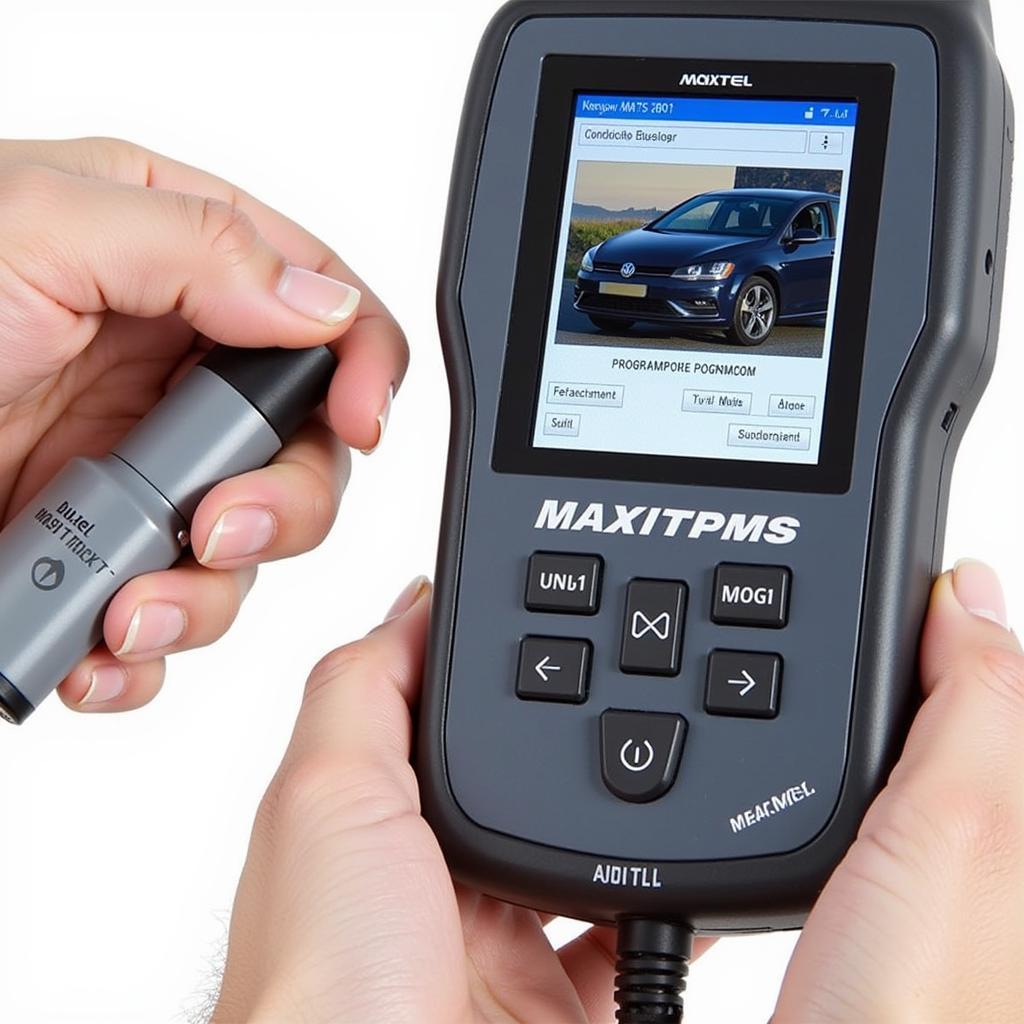Autel MX sensors interchangeable stems offer a versatile and cost-effective solution for TPMS service. These sensors simplify inventory management and reduce costs by allowing technicians to use a single sensor with various interchangeable valve stems. This comprehensive guide dives deep into the world of Autel MX sensors and their interchangeable stems, exploring their benefits, compatibility, and how they can revolutionize your TPMS service.
Understanding Autel MX Sensors and Interchangeable Stems
Autel MX sensors are programmable universal TPMS sensors designed to replace a wide range of OE sensors. Their key feature is the ability to use different valve stems, offering flexibility for various vehicle applications. This interchangeability reduces the need to stock multiple sensor types, streamlining inventory and saving valuable time and money. Whether you’re dealing with a domestic or foreign vehicle, an aluminum or rubber valve stem, Autel MX sensors have you covered.
Benefits of Using Interchangeable Stems
The primary benefit of interchangeable stems is simplified inventory management. Instead of stocking numerous sensors for different vehicle makes and models, you can keep a smaller, more manageable inventory of Autel MX sensors and a selection of valve stems. This not only saves storage space but also reduces the risk of obsolete inventory. Additionally, using interchangeable stems can significantly reduce costs by minimizing the number of sensors you need to purchase.
Compatibility and Coverage of Autel MX Sensors
Autel MX sensors boast extensive vehicle coverage, compatible with a vast majority of domestic and foreign vehicles. This broad compatibility makes them a valuable tool for any TPMS service professional. Before purchasing, it’s crucial to consult Autel’s online lookup tool or the MaxiTPMS TS601/TS508K/TS408/TS401 tools to ensure compatibility with the specific vehicle you’re working on. This ensures accurate sensor programming and proper functionality.
How to Choose the Right Autel MX Sensor Stem
Choosing the correct Autel MX sensor stem depends on several factors, including the vehicle’s make and model, the type of wheel, and the customer’s preference. Aluminum stems are known for their durability and aesthetic appeal, while rubber stems offer flexibility and are often preferred for vehicles with alloy wheels. Consider the specific requirements of the vehicle and the customer’s needs when selecting the appropriate stem.
Installing and Programming Autel MX Sensors
Installing Autel MX sensors is a straightforward process, but proper procedures must be followed for optimal performance. After installing the sensor and the chosen valve stem, it’s essential to program the sensor using a compatible Autel TPMS programming tool. The programming process involves transferring the sensor ID to the vehicle’s ECU, ensuring proper communication between the sensor and the TPMS system.
Troubleshooting Common Issues with Autel MX Sensors
While Autel MX sensors are generally reliable, occasional issues can arise. Common problems include slow leaks, sensor malfunction, and communication errors. These issues can often be resolved by ensuring proper installation, verifying sensor compatibility, and using the correct programming procedures. Consulting Autel’s troubleshooting guide or contacting their technical support can provide valuable assistance in resolving any issues.
Why should I choose Autel MX sensors with interchangeable stems?
Choosing Autel MX sensors with interchangeable stems simplifies inventory management and reduces costs by allowing you to use a single sensor type with various valve stems.
Where can I find compatible stems for my Autel MX sensors?
You can find compatible stems through authorized Autel distributors or online retailers.
 Autel MX Sensor Programming using TS601
Autel MX Sensor Programming using TS601
Conclusion: A Smart Investment for Your TPMS Service
Autel MX sensors with interchangeable stems are a smart investment for any TPMS service professional. Their versatility, cost-effectiveness, and broad vehicle coverage make them a valuable addition to your toolkit. By simplifying inventory management and reducing costs, Autel MX sensors contribute to a more efficient and profitable TPMS service. Investing in Autel MX sensors is investing in the future of your business.
FAQ
- Are Autel MX sensors compatible with all vehicles? No, while they offer broad coverage, it’s essential to check compatibility using Autel’s resources.
- Can I reuse Autel MX sensors? Yes, they are designed to be reusable and reprogrammable.
- What is the lifespan of an Autel MX sensor? The lifespan varies depending on usage and conditions, but they are designed for long-term use.
- What programming tools are compatible with Autel MX sensors? Autel’s MaxiTPMS tools, such as the TS601, TS508K, TS408, and TS401 are compatible.
- Where can I purchase Autel MX sensors and interchangeable stems? Authorized Autel distributors and online retailers.
- What are the different types of interchangeable stems available? Common types include aluminum and rubber stems in various lengths and angles.
- How do I troubleshoot a malfunctioning Autel MX sensor? Consult Autel’s troubleshooting guide or contact their technical support.
Common Scenarios and Questions
- Scenario: A customer arrives with a damaged valve stem. Question: Can I just replace the stem without replacing the entire sensor? Answer: Yes, with Autel MX sensors, you can simply replace the damaged stem with a new compatible one.
- Scenario: A shop is looking to streamline its TPMS inventory. Question: Will using Autel MX sensors significantly reduce the number of sensors I need to stock? Answer: Yes, the interchangeability of stems allows for a smaller, more manageable inventory.
Further Resources
For more information, explore our other articles on TPMS service and Autel products. You can also find helpful videos and tutorials on our website.
Need Help?
When you need support, please contact WhatsApp: +1(641)206-8880, Email: [email protected] Or visit: 276 Reock St, City of Orange, NJ 07050, United States. We have a 24/7 customer service team.


